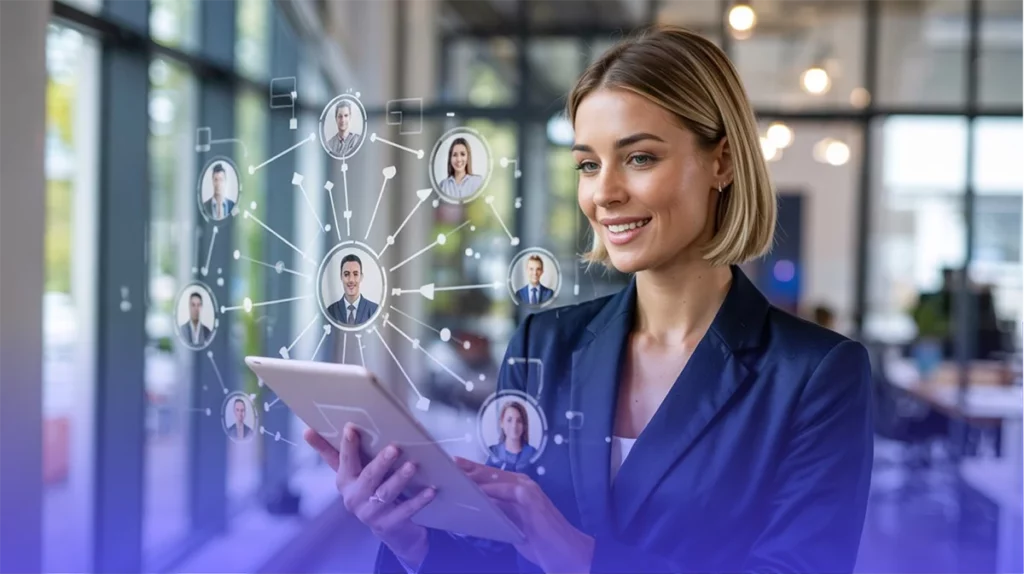Andrea Pedrini: AI in HR? It helps find talent, but it must not replace the human factor.

Artificial intelligence is becoming an integral part of our lives – and the HR field is no exception. How is AI impacting talent acquisition? Why is Europe more cautious in regulating it compared to the US? And how are Italian companies approaching it?
We discussed all this with Andrea Pedrini, an Italian expert in HR and technology, who helps companies effectively leverage digital tools.
Artificial intelligence is a big topic that affects everyone’s lives—how we use it and how we work with it. Do you see it the same way?
We use AI every day—sometimes without even knowing we’re using it. It’s important to understand how we can apply AI and what type of AI tool we’re using, because some carry risks. But in other cases, they are powerful and useful systems. And of course, this applies to our work as well, including the HR field. HR departments need to understand that artificial intelligence is a truly powerful tool.
Currently, the main focus is on generative AI, but there are other types too—machine learning, deep learning systems. That’s something I highlight in my tech talks. I need to show HR professionals and future HR practitioners that even if it feels unfamiliar, they don’t need to be afraid. They just need to learn how to work with these tools to use them effectively.
Italy has a specific approach to AI and personal data protection. You even have a special authority, GPDP, that oversees GDPR. Are there any unique legal specifics or restrictions?
GDPR itself already brings certain restrictions. Article 22.1 limits the use of AI in repeated and ongoing evaluation when used as a comparison system without oversight. In Italy, the bar is set even higher, and I believe it helped shape the foundation of the AI Act at the EU level.
For example, in Italy, it’s problematic to use AI in subjective, interpretive contexts. Think of a situation where I’m speaking to you and an AI is analyzing your facial expressions to judge whether you’re “good” or “bad” based on speech and gestures.
In Italy, and I think in Germany too, there are stricter regulations in this area. But it always depends on the use case. I don’t see many restrictions when it comes to using generative AI—everyone can use it. The real issue is subjective AI judgments, which can be problematic.
Let’s talk about generative AI—for example, creating videos. Say we film a video in English, then translate the audio into Italian using AI, and sync it to the original person. How is this kind of AI use perceived in Italy?
In Italy, legally there’s no issue with this use of generative AI. The concern is more cultural—how people talk about and perceive AI. Legally, it’s fine, but people may react differently.
It always depends on how AI is used. AI can be used for good or misused. On TikTok or similar platforms, you’ll see AI videos of the U.S. president saying things he never actually said.
The power and potential of this technology inevitably raise concerns about misuse, and there’s ongoing discussion about setting boundaries. Controlling it is difficult—it’s hard to tell whether a given message is fake or not. AI is easy to abuse, and fake news is a legitimate concern.
How are Italian companies adopting AI? ChatGPT was blocked for a while—did that affect adoption within other tools and company processes?
Yes, many companies don’t use ChatGPT externally at all, only internally in a secured and isolated system. Others don’t worry about it much. But every company wants to use AI—they recognize its daily potential. They’re also dealing with various process-related challenges.
Larger companies already have dedicated teams who can say: “This is okay, we can use AI like this.” Or they flag potential issues regarding the AI Act, which is under scrutiny now and will be fully enforced by 2026—so preparations are in full swing.
AI is definitely the number one topic. Remember two years ago when everyone was excited about the Metaverse? Now nobody cares—it’s all about generative AI. Every company is trying to make the best use of this technology.
Generative AI is well-received by companies, especially in HR, where it significantly streamlines processes—creating job descriptions, gathering information, standardizing tasks across departments.
At Sloneek, we have our own AI. Larger companies in the Czech Republic are starting to do this too—building internal AI with their own data. Is this common in Italy?
Definitely. Of course, not all companies—smaller ones tend to rely on ChatGPT. Internal AI is used by companies that have in-house IT teams and the capacity to develop and maintain their own systems—like banks such as Generali.
Internal systems do have limits. If you’re using your own AI, it has less data available to generate something meaningful.
Besides large enterprises, smaller and medium-sized companies are also focusing on AI in Italy. In HR, the focus is very strong—optimizing processes, cutting costs, and more.
When you meet with a large company, they’ll talk about how they want to use AI or how they’re already using it. And SMEs know that AI is scalable—so eventually, the cost goes down and they start using it too.
AI is a global topic. And its rollout is similar around the world.
Yes, though I don’t think the situation is quite the same in the U.S.
True, I think the U.S. is more open—they’ll start using a tool and stop if it causes problems. In Europe, we try to prevent risk before use. That’s the European approach. I think China is more “do whatever you want.” Europe is more conservative.
In the Czech Republic—especially in Prague and bigger cities—AI adoption is moving quickly. But in smaller towns and companies, it’s just starting. Is it the same in Italy?
Very similar. I believe that in HR we’ll see big, rapid tech changes in the next year, five years, ten years—driven by digitization.
AI is a huge opportunity. Yes, it’s advancing fast. And if you want to benefit from it, you need to keep up. It’s not easy—humans are analog by nature. Now we have to become digital. It’s hard, but it’s the way forward.
Italy is investing heavily in infrastructure and expanding internet access, which supports and opens up new opportunities, including AI deployment. There’s huge progress in digitalization. Where paper once ruled, now phones and iPads are king—sales is a great example.
And predictive AI is another powerful aspect—its ability to understand next steps based on data analysis.
Let’s talk about how AI helps in HR processes. At Sloneek, we use it mainly for onboarding, working with CVs, and analyzing them. How do Italian HR departments use AI?
I worked with a company that used a matching algorithm on career pages to help candidates find the best-fit roles.
Of course, it works both ways—if you’re hiring for a role and have hundreds of CVs, AI can help you compare data and select the best candidates.
Many companies use this kind of tech—some successfully, some less so. Like with anything, some tools are better than others.
I see a shift from machine learning to deep learning. Big companies now prefer deep learning because it works instantly. Most companies use generative AI based on deep learning, especially in the early stages of talent acquisition.
We’re also dealing with a major problem in Italy—and probably in most of Europe—the shortage of skilled people and a mismatch of competencies. The number of qualified candidates is dropping—we’ve hit a peak, and now it’s declining.
Fewer people also means fewer quality candidates—it’s a matter of ratios. That’s why companies and HR departments are turning to AI to find the right people internally. Sometimes, there’s no need to go to the job market—you can just look within. Competency mapping helps identify internal talent and find the ideal fit.
We’re seeing the same issue in the Czech Republic.
Yes, I think it’s a Europe-wide issue. In India or China, it’s different—it’s just a matter of quantity. And also of university and education type. We have tons of lawyers, but we need engineers. So the mismatch is a real challenge. But AI helps a lot.
Are there areas in HR where AI can’t be implemented?
My view is that we’re talking about Human Resources. The word “human” is important. You can use AI to analyze data, but at the end of the day, it’s a person working with a candidate. This kind of work is about relationships—a human part that can’t be replaced. I think most HR professionals would agree.
You can build processes with AI, but relationships, the ability to judge if someone is the right fit, or to understand if someone in your company is struggling—that’s the human side, not the technical one.
Italian influencer Marco Montemagno says the next unicorn will be a company that makes massive profits with just one person inside, and AI running every system. He predicts that in 10 years, we’ll see this kind of unicorn—a company without people, run entirely by tech.
What does good AI implementation in a company look like?
I think the focus is mainly on talent acquisition. The technology is generative—it helps quickly generate information. Many companies already use AI to match candidates with roles.
How do we prepare employees for AI? In HR, especially among older staff, there’s often fear and resistance. They might stick with their old spreadsheets and avoid tools like Sloneek. What’s your take?
I used to work with Excel before moving to an ATS. Change is hard—people fear not understanding the new tool, or just don’t want to deal with change. It takes effort.
But we all need to keep learning and improving—it’s part of the job. And the same goes for companies. If you fall behind, you’re out of the market. You can’t be afraid—but you also need to understand what’s good and bad for you. You won’t know that unless you interact with AI and tech. And if you don’t do it, someone else will—and they’ll outpace you.
How do you personally use AI?
I use it because I need to keep learning and understand it in order to demonstrate how it works. In some companies, I even sell this kind of tech. For example, I work with an Italian company that is adapting Spanish AI tech.
AI helps me present solutions to clients. In the end, I use AI far more than I realize—many tools run on AI behind the scenes, and we don’t even know it.
When searching for answers, do you use Google or ChatGPT more?
Honestly, Google. But sometimes I also use ChatGPT or Genesis—for example, to create simple content videos, design mockups, or prep presentations.






